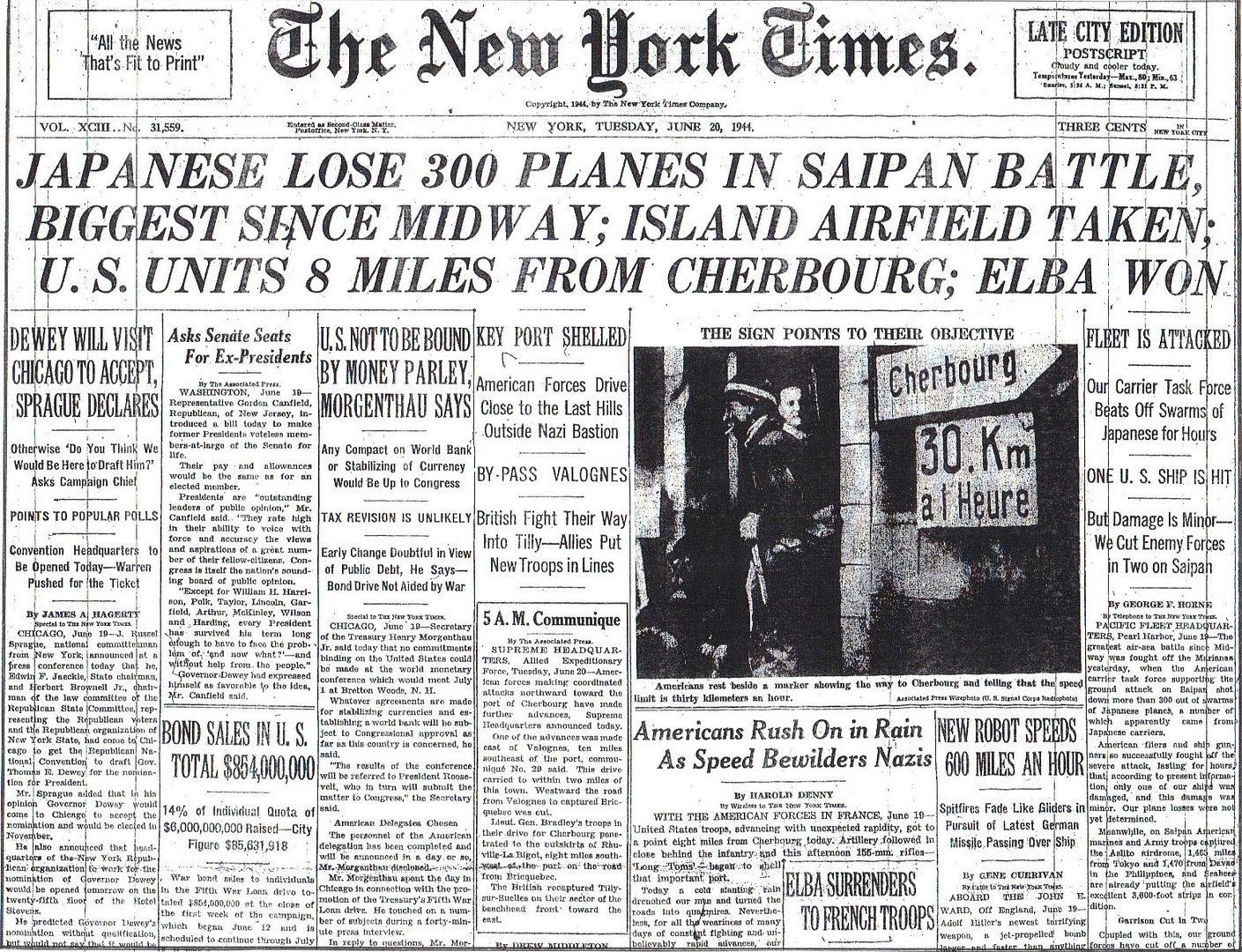
Posted on 06/20/2014 4:31:31 AM PDT by Homer_J_Simpson

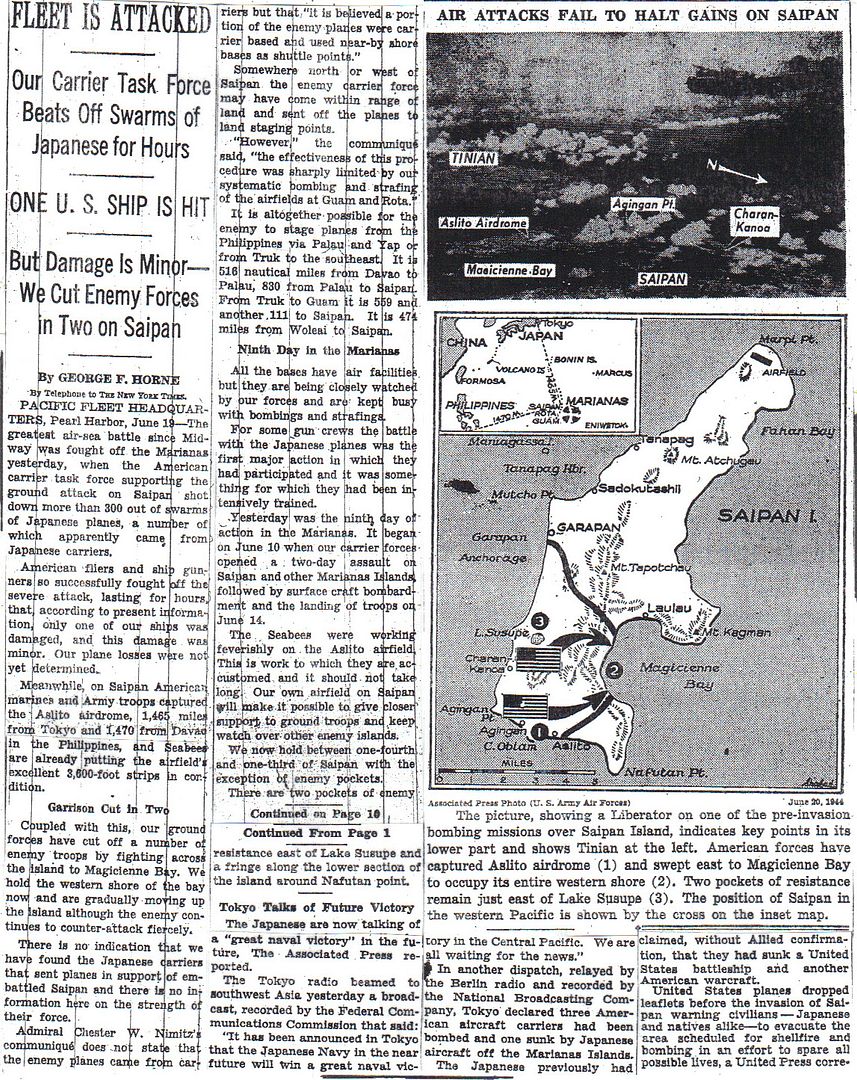

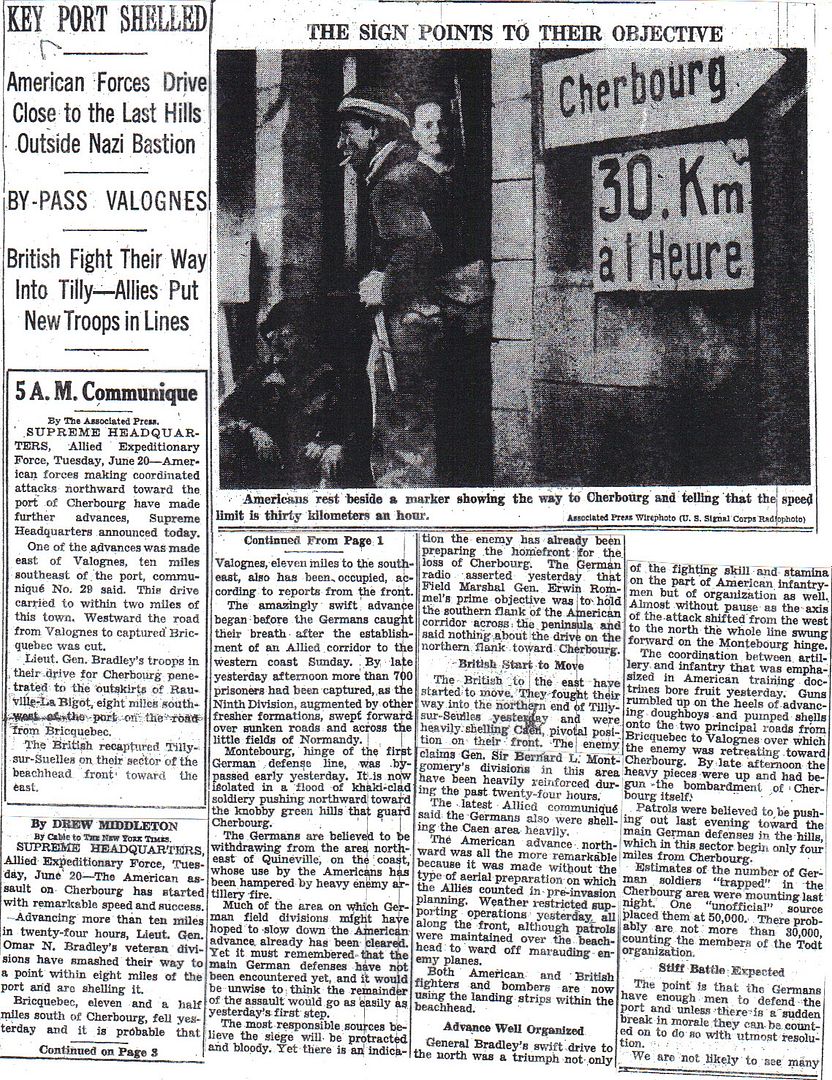
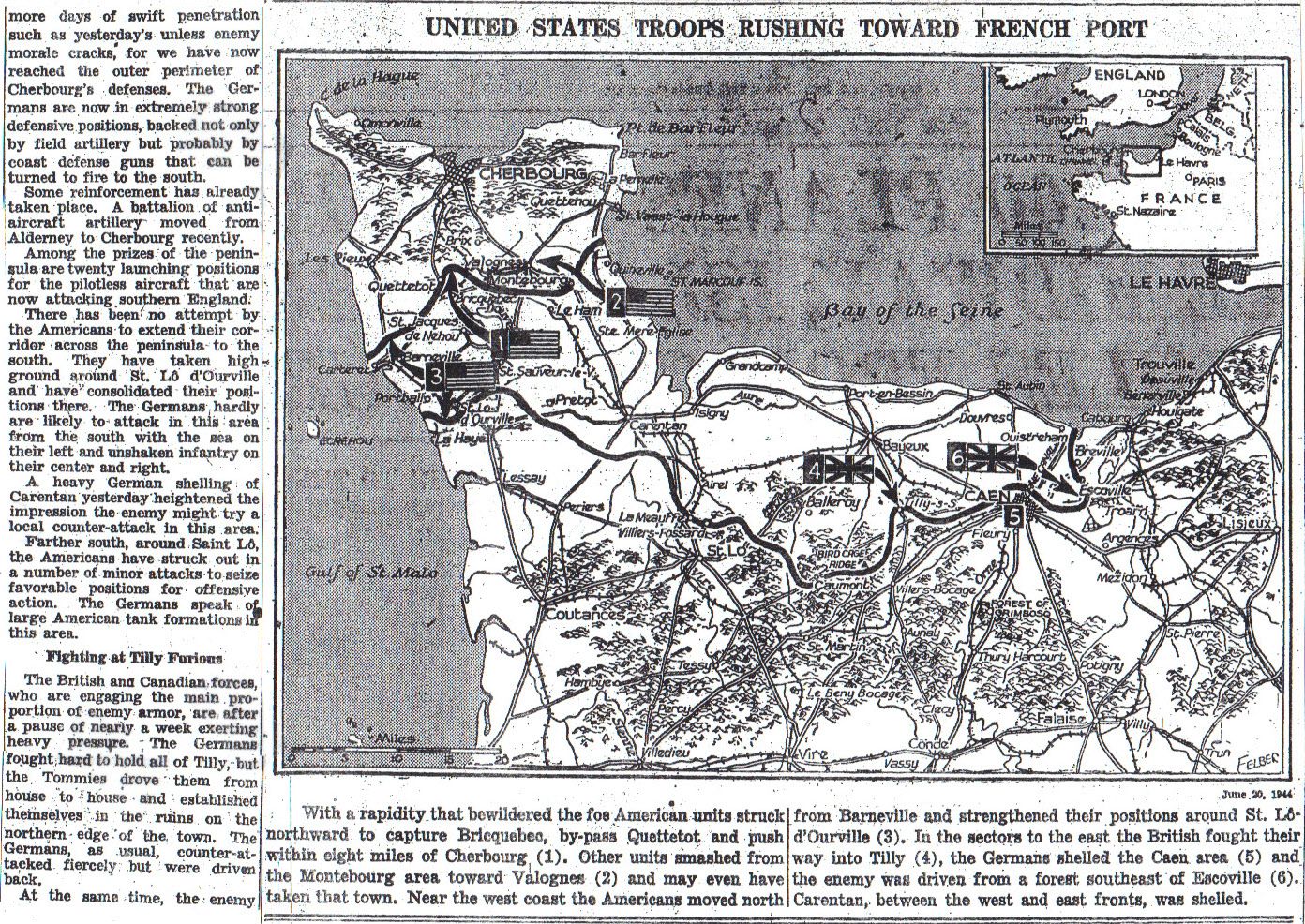
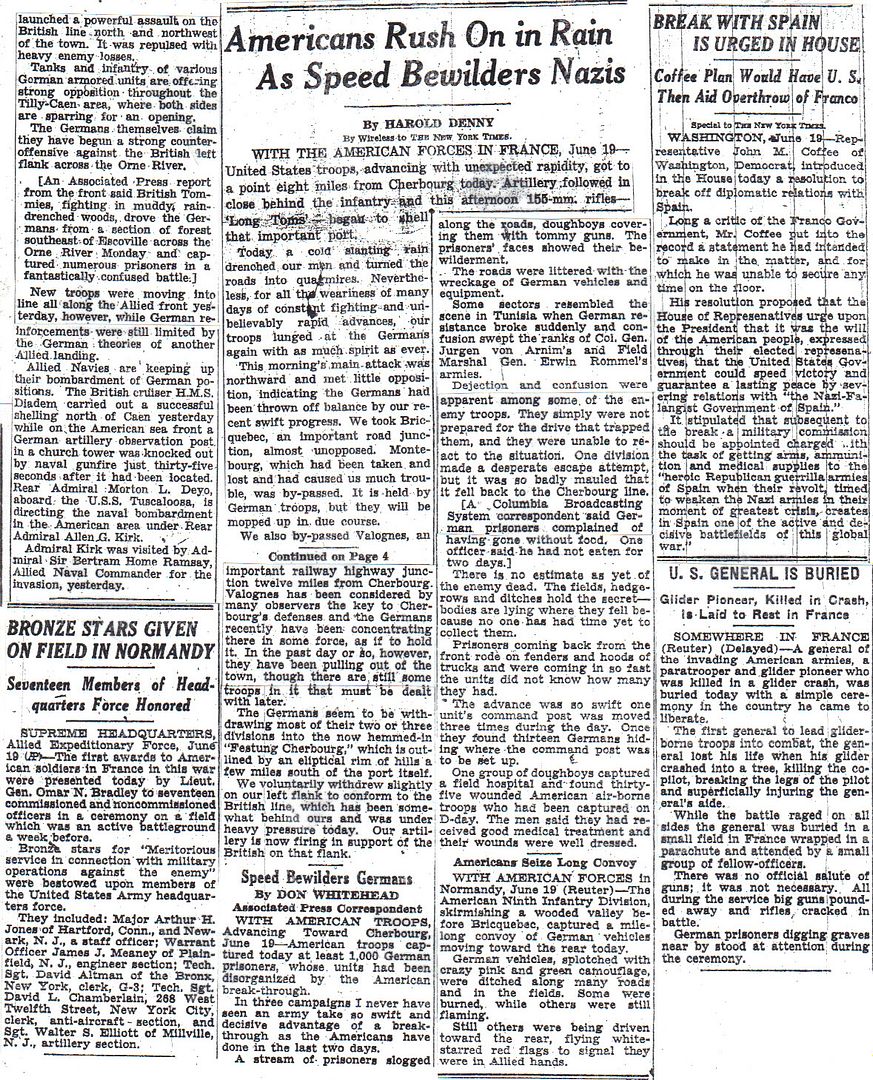
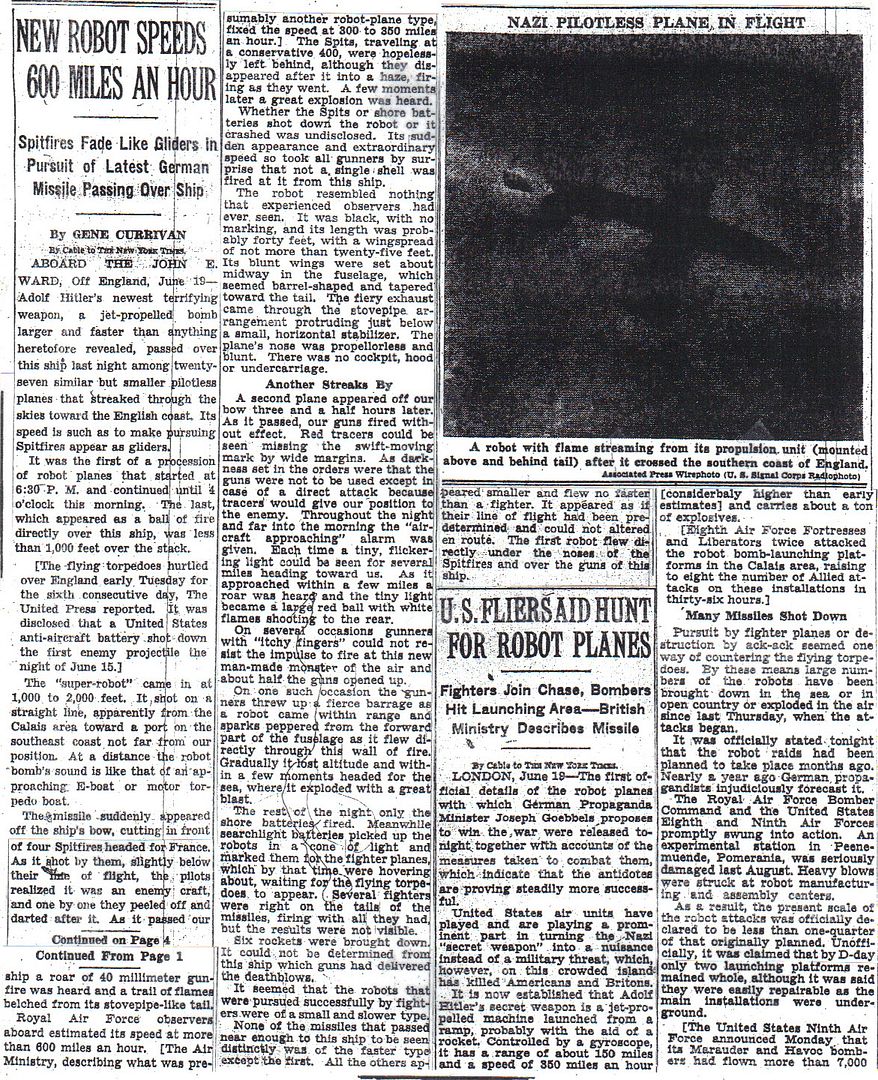
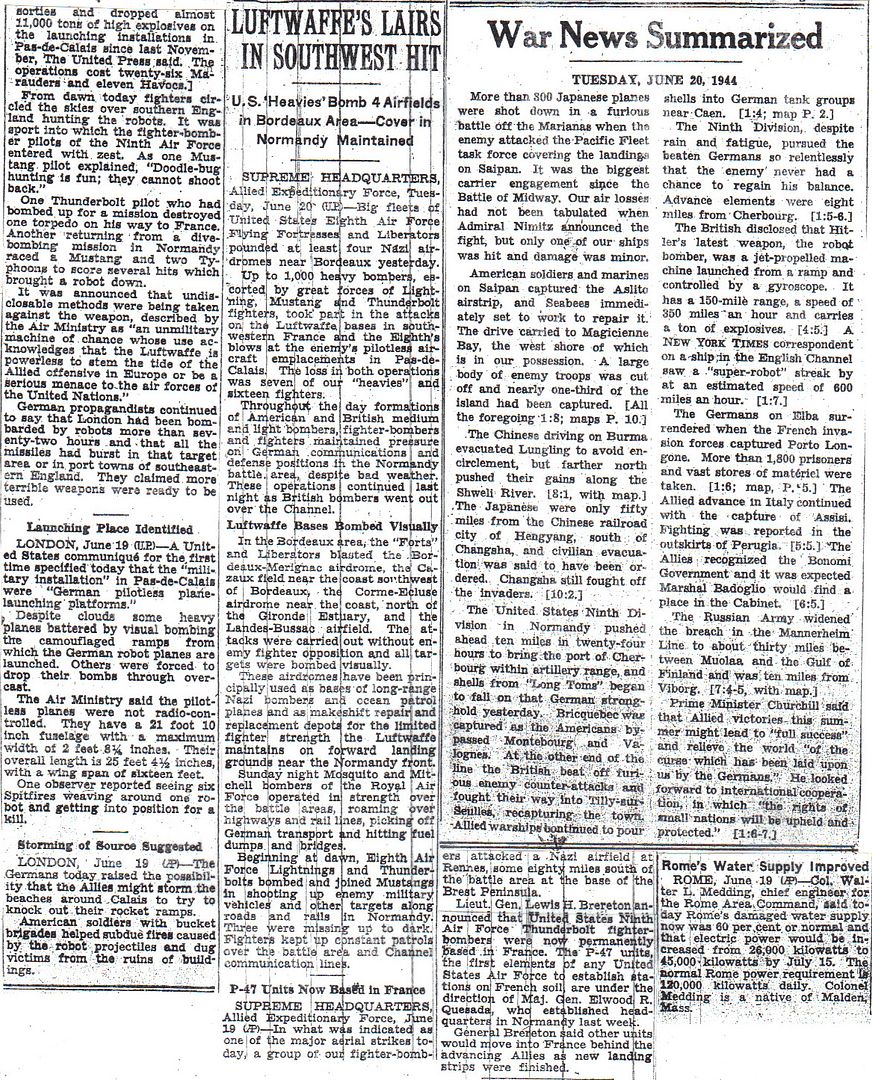
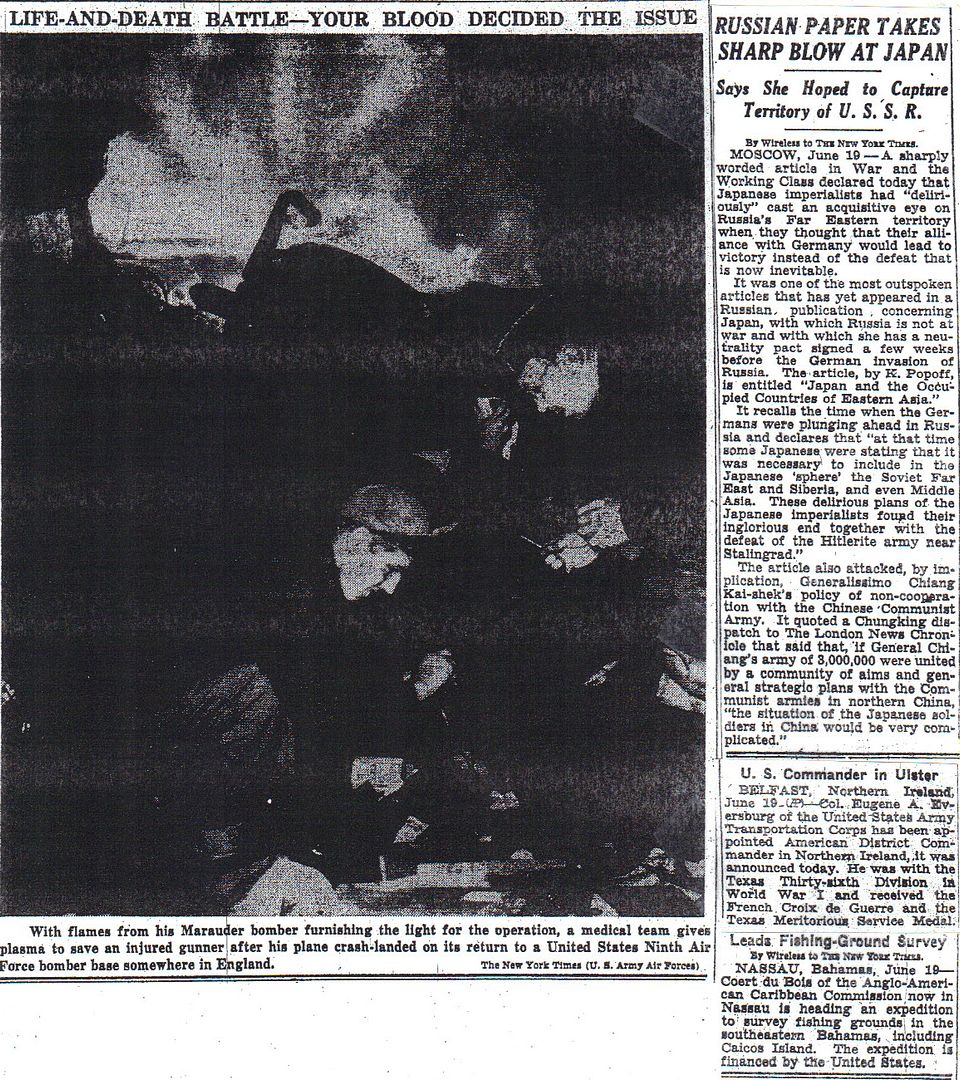
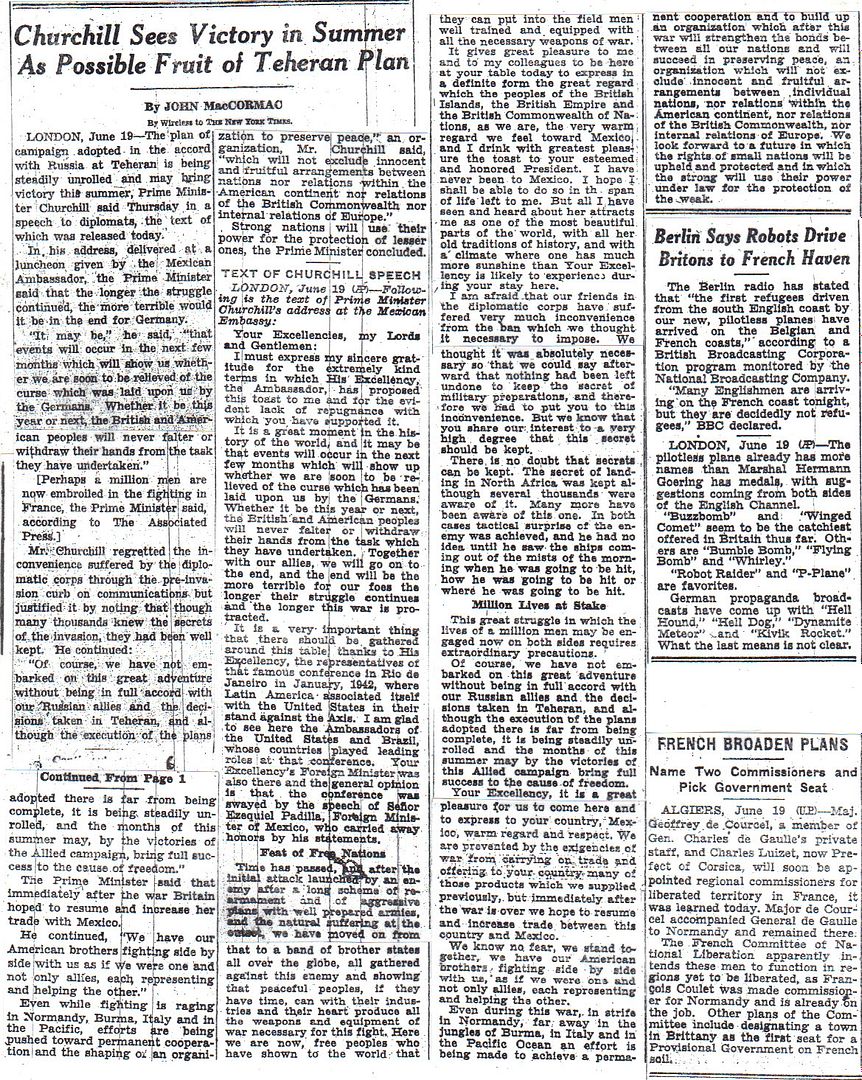

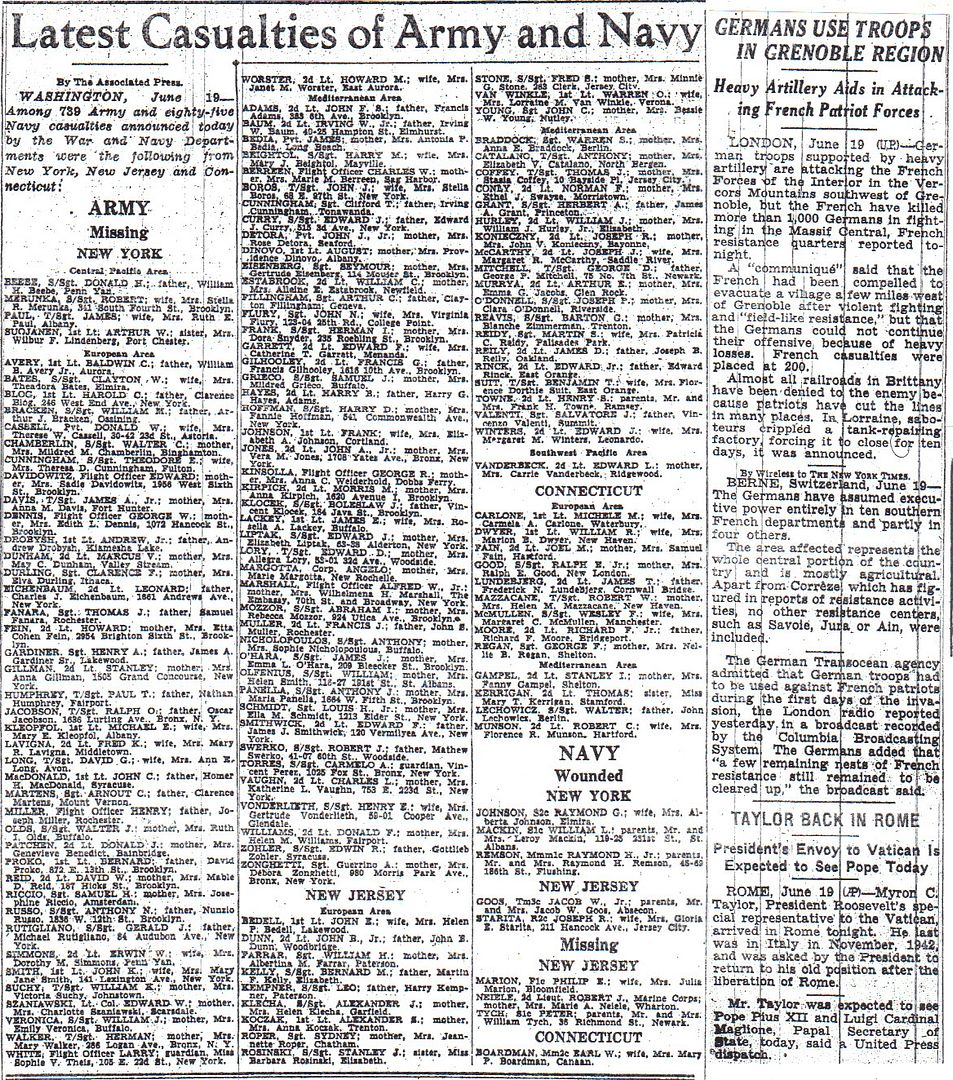
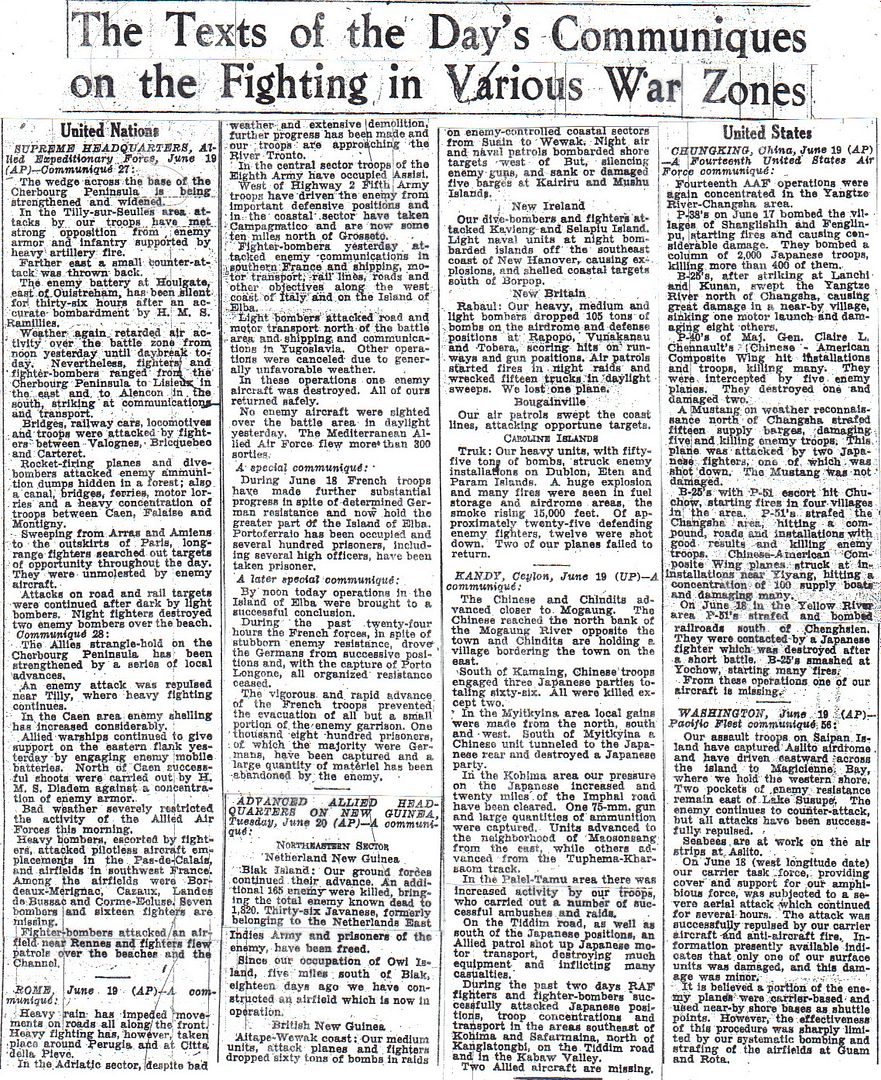
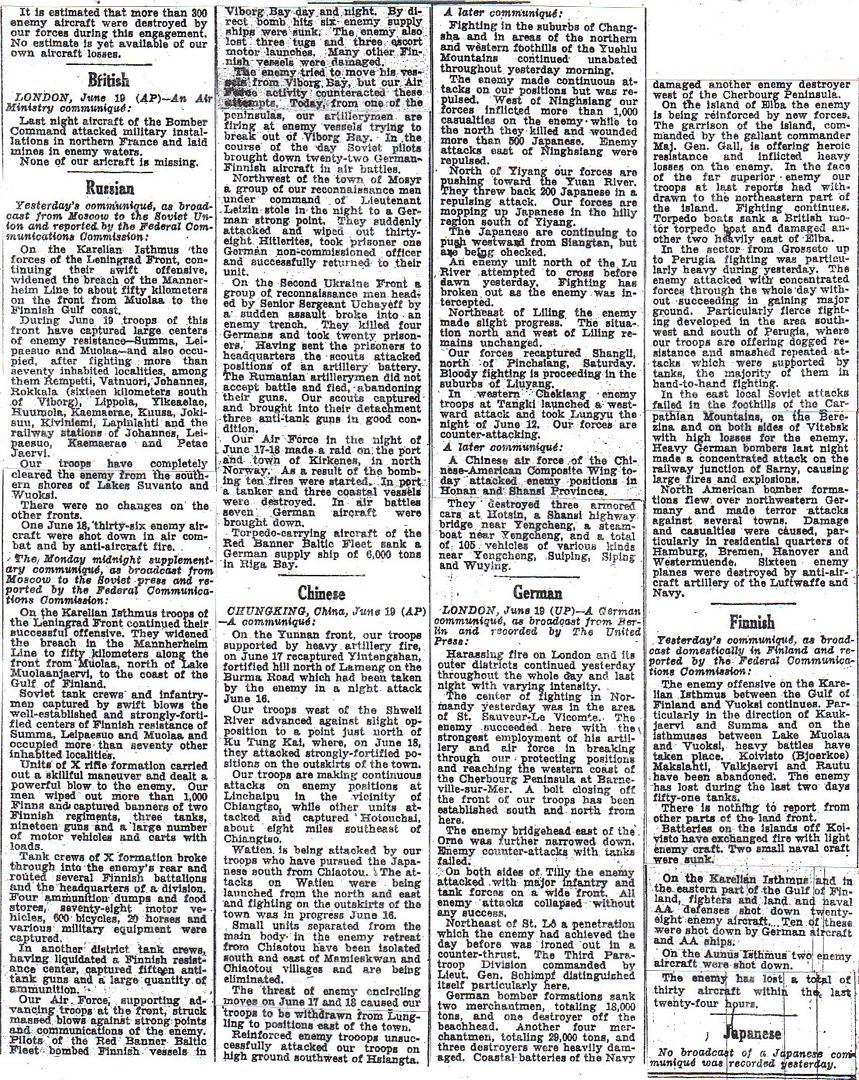
http://www.onwar.com/chrono/1944/jun44/20jun44.htm#
Americans approaching Cherbourg
Tuesday, June 20, 1944 www.onwar.com
American soldier in position just outside Cherbourg [photo at link]
On the Western Front... Elements of the US 1st Army advance to about 5 miles of Cherbourg and begin to encounter heavier resistance.
In Italy... The British 8th Army continues to advance. British 6th Armored Division captures Perugia.
On the Eastern Front... Forces of the Soviet Leningrad Front capture Viipuri.
In the Philippine Sea... The Japanese fleet withdraws to refuel, believing that their aircraft have landed safely on Guam. US Task Force 58 (Admiral Mitscher) launches an air strike on the Japanese fleet in the late afternoon. The 216 American aircraft encounter 35 defending fighters and sink the carrier Hiyo. Two other Japanese aircraft carriers are damaged as are a battleship and a cruiser. US loses amount to 20 planes shot down and 72 crashing while attempting to land on their carriers in the dark. During the night, the Japanese fleet withdraws and are not pursued.
In New Guinea... On Biak, there is fighting among the Japanese-held caves in the west of the island. The airfields and villages at Borokoe and Sorido are overrun by American forces.
In the Mariana Islands... The US 5th Amphibious Corps continues operations on Saipan. The US 27th Division clears the south of the island while the US 2nd and 4th Marine Divisions advance northward.
http://www.etherit.co.uk/month/thismonth/20.htm
June 20th, 1944 (TUESDAY)
UNITED KINGDOM:
The USAAF’s Eighth Air Force in England flies three missions.
Mission 425: In the morning 1,548 bombers, in five forces, are dispatched to attack 14 strategic targets in northern Germany and V-weapon sites in France; 49 bombers are lost.
1. 126 B-24 Liberators bomb V-weapon sites in the Pas de Calais area; one B-24 is lost; escort is provided by 44 P-47 Thunderbolts; they claim 3-0-0 Luftwaffe aircraft; one P-47 is lost.
2. Of 341 B-17 Flying Fortresses dispatched, 137 hit Fallersleben, 95 hit Magdeburg/Rothensee and 52 hit Konigsberg; they claim 2-0-6 Luftwaffe aircraft; six B-17s are lost.
3. Of 191 B-24s, 169 hit Hannover/Misburg and three hit a target of opportunity; one B-24 is lost; escort is provided by 98 P-38 Lightnings, 86 P-47s and 38 P-51 Mustangs and 81 Ninth Air Force P-51s; they claim 10-1-10 Luftwaffe aircraft in the air and 8-0-3 on the ground; one P-38, one P-47 and one P-51 are lost.
4. Of 512 B-17s dispatched, 107 hit Hamburg/Eurotank oil refinery, 60 hit Harburg/Ebano oil refinery, 54 hit Hamburg/Schliemanns oil refinery, 53 hit Harburg/Rhenania oil refinery, 53 hit Hamburg/Deut.Petr.AG, 50 hit Hamburg/Rhenania-Ossag oil refinery, 26 hit Hamburg/Schindler oil refinery, 12 hit Brunsbuttel canal lock and two hit targets of opportunity; seven B-17s are lost; escort is provided by 96 P-38s and 48 P-47s.
Personal Memory: My diary for today reads: “Hamburg (Yipe!) Germany, Bombed oil refinery and storage. Made good use of CAVU weather. Sure went up in flames. FLAK so thick you couldn’t see through it but we flew through it. Got plenty of holes this trip. (263). Sure earned that Oak Leaf Cluster” (to air medal.) The 303rd Bomb Group furnished 39 B-17s for this seven hour mission. Each plane was loaded with 2,100 gallons of fuel and twelve 500 pound bombs that we were to drop on the Rhenania-Ossag Mineralolwerkes A.G. from 25,000 feet. The Eighth Air Force put up 853 B-17s and 695 B-24s to make a total of 1,548 heavy bombers and with clear weather it went well for the attackers. The attackees were also busy with their FLAK guns and we made it easy for them by flying a 41 mile bomb run against a headwind making our ground speed barely over 120 MPH which gave the German gunners 15 minutes to track us in a straight line. Every now and then we could see a bomber go down. Our bo mbs were fused at one tenth second at the nose and one fortieth at the tail and we busted the target wide open with raging fires out of control. Of our 39 bombers only two escaped damage. Eleven, including our “Buzz Blonde” suffered major damage and three crew members were wounded by FLAK. Our Bombardier, Ed Cooper was flying with our wingman for training a new bombardier. While on the bomb run a piece of FLAK came in the nose, struck him in the center of his chest and knocked him six feet back into the navigators position. The FLAK suit obviously saved his life and we helped him cut it out. The FLAK suit is quite a piece of work with overlapping tantalum plates that clasped the piece of shrapnel saving him from a severe penetrating wound. All he got was a big bruise on his chest. And no purple heart. A few flight crews were recommended an extra DFC, including Beiser and me, since we flew the airplane with two broken cables. When the powers that be found that the airplane did not react to any of this damage the idea was dropped. It took 4 days to repair our poor old Buzz Blonde and tomorrow we would have to take another plane to Berlin. Ouch! Score: Milk Runs 12, Others 6. (Dick Johnson)
5. Of 358 B-24s, 245 hit Politz, 71 bomb Ostermoor and 12 hit targets of opportunity; they claim 10-3-2 Luftwaffe aircraft; 34 B-24s are lost; escort is provided by 50 P-38s and 221 P-51s; they claim 28-1-9 Luftwaffe aircraft in the air and 5-0-9 on the ground; three P-38s are lost.
Mission 426: In the afternoon, 33 B-17s and 196 B-24s attack ten V-weapon sites in the Pas de Calais area; one B-24 is lost; escort is provided by 72 P-47s and 40 P-51s.
Mission 427: Five B-17s drop leaflets in France during the night.
25 B-24s fly CARPETBAGGER missions in France.
Submarine HMS Utica commissioned.
Repair ship HMS Assistance launched.
Submarine HMS Volatile launched.
Minesweeper HMS Hare launched.
FRANCE: US forces become entangled with the outer defences of Cherbourg about 5 miles form the City.
About 370 B-26 Marauders and A-20 Havocs of the USAAF’s Ninth Air Force bomb nine V-weapon sites and a coastal defence battery at Houlgate; 1,000+ fighters operating over frontline areas, the Cherbourg Peninsula, and south to Dreux, bomb and strafe rail lines, marshalling yards, bridges, troop concentrations and other targets.
GERMANY: Colonel Count Claus von Stauffenberg, a conspirator in a plot by high-ranking army officers to stage a coup against Hitler, is appointed chief of staff to General Friedrich Fromm, so gaining access to Hitlers headquarters.
FINLAND: The Red Army captures Viipuri (Vyborg), the second largest city of pre-war Finland, and one of the main reasons Finland went to war in 1941. Its capture marks achievement of the first Soviet objective and the lowest point of Finnish fortunes in the war. VKT-line, the third and last line of defence, is already dented.
Viipuri was defended by Col. Armas Kemppi’s recently arrived 20th Brigade. Brigade hadn’t seen much action, but had been employed in labour details and fortification works. After the Soviet offensive began, it was transferred to the Karelian Isthmus. It has spent the last two days settling into defence, while the demoralized men of the 10th Division and Cavalry Brigade retreated through its positions, spreading horror-stories about the Soviet might.
The untried and nervous men of the brigade lack ammunition, AT-weapons and artillery support. Col. Kemppi does his best to procure these from the IV Corps, but is hampered by petty bureaucracy (the story goes that Viipuri was lost because one supply-sergeant wouldn’t surrender the keys for an ammunition storage in time).
After artillery and aerial bombardment the Soviet attack begins in afternoon. It is directed against Maj. Kurt Bäckman’s II Battalion. Just before the forces come into contact, one platoon leaves its positions (believing a rumour that they were ordered to withdraw) and soon the rest of the battalion follows suit. Major Bäckman tries in vain to get the panicking men back to their positions. Col. Kemppi send his reserves to plug the hole in defences, but his means of directing the battle are severely curtailed after his communications break down. The enemy tanks advance to the centre of the city practically without opposition. The last defenders, Col. Kemppi among them, leave the city at 4.45 pm. At the last moment 2nd Lt. Eelis Mäkinen manages to secure the Finnish flag from tower of the city’s medieval castle.
After the loss of Viipuri, it was Col. Kai Savonjousi’s alertness that finally saved Finns from an even worse disaster. When he received the first news that the 20th Brigade was leaving the city, Col. Savonjousi, on his own initiative, sent troops to plug the gaping hole west of the city. On the next two days men of Col. Savonjousi’s 10th Division repelled the first Soviet attempts to advance west from Viipuri.
Late in the evening Commander of the Isthmus Troops Lt. Gen. Karl Oesch and commander of the IV Corps Lt. Gen. Taavetti Laatikainen agree that there’s no use trying to recapture Viipuri. The forces available aren’t in the shape to try to dislodge a strong enemy from the city [Also, while Viipuri was of great moral and symbolic significance, its strategic value was rather low.]. New defence-line is to be established just west of Viipuri.
The first the Finnish GHQ hears of the loss of Viipuri, is when radio-intelligence captures a message from a Soviet tank commander, stating that he has just reached the centre of the city. Col. Kemppi and Major Bäckman are later court-martialled and found guilty in January 1945. The War Court condemned Kemppi of ‘dereliction of duty that damaged the war effort partly due to carelessness and partly due to neglect’. His sentence was eight months of penitentiary detention. Major Bläckman shot himself six days afterwards. The Supreme Court reviewed the sentences in March 1945. Kemppi’s sentence was changed to 25 days of detention and bizarrely, the late Bäckman’s sentence to one year of penitentiary detention. (see more)
The Finnish commanders at the Karelian Isthmus receive an appeal written by Mannerheim the previous day. He demands that VKT-line be held at all costs. “I’m aware that work on this line is either non-existent or only just beginning, but I trust that the Finnish soldier can exploit the terrain and his guts [sisu] to achieve an unwavering defence.”
On Maaselkä Ishmus (between Lake Onega and White Sea), Maj. Gen. Einar Mäkinen’s II Corps (Maj. Gen. Uno Fagernäs’s 1st Division and the 21st Brigade) is facing Gen. Gorolenko’s 32nd Army. Today Gorolenko’s four divisions start probing the Finnish positions, preparing for a larger offensive. This is the sign for Gen. Mäkinen to start his previously planned withdrawal. II Corps withdraws to a well-prepared position running from Karhumäki (Medvezhjegorsk) through Osterjärvi to Liistepohja.
A heavy air attack to mine depot on Kirkonmaa Island sank two mine transporters and blow up the mine depot. About 600 mines and anti-sweeping devices were lost.
U.S.S.R.: The Red Army masses 166 divisions and 5,000 tanks in Byelorussia, poised for Operation Bagration.
ITALY: British troops take Perugia.
INDIA:
In the China-Burma-India Theater, the unified Eastern Air Command (EAC), which has operational control of RAF and USAAF units in the CBI, is reorganized into six components:
1. EAC Strategic Air Force consisting of RAF and USAAF heavy bombers.
2. Third Tactical Air Force consisting of RAF and USAAF medium bombers.
3. Photographic Reconnaissance Force consisting of RAF and USAAF photo recon units.
4. Tenth Air Force consisting of USAAF fighter and troop carrier units and a combat cargo squadron.
5. RAF 239 Wing
6. Air Task Force consisting of the USAAF’s 1st Air Commando Group and 3d Combat Cargo Group.
COMMONWEALTH OF THE PHILIPPINES: A USN submarine in the Pacific sinks an army cargo ship.
The submarine USS Narwhal (SS-167) lands four U.S. enlisted men and supplies on Panay Island in the Philippines and then evacuates 13 men and one woman.
MARIANAS ISLANDS: The Japanese Fleet withdraws after yesterdays action against TF 58. They intend to refuel so they can continue their plan with the aircraft launched yesterday. They believe these planes have landed on bases in the islands. They are unaware of the actual losses.
Late in the afternoon, planes from TF 58 are attacking. The carrier Hiyo is sunk, a battleship and a cruiser are damaged. The returning US strike plans reach their carriers in darkness. Admiral Mischner orders the flight decks illuminated to assist their return. Although 72 planes are lost in addition to the 20 in combat; only 16 pilots and 33 aircrew are not rescued.
Jack McKillop adds: At 0230 hours, a detachment of Night Fighting Squadron Seventy Seven [VF(N)-77] equipped with Grumman F6F-3N Hellcats in USS Essex (CV-9) find that the Japanese have turned the lights on at the Tiyan Airstrip on Guam.
The Hellcats strafe the airstrip until the lights are turned off. The lights go on again at 0410 hours and the F6F-3N Hellcats destroy 3 of 4 Aichi D3A Navy Type 99 Carrier Bombers, Allied Code Name “Val,” that are taking off. Task Group 58.4, the carriers USS Cowpens, USS Essex and USS Langley, that has remained off the Mariana Islands launches against Guam and Rota Islands; the Americans destroy 18 Japanese aircraft in the air and 52 on the ground at Orote Field on Guam.
During the night of 19/20 June, the USN’s Task Groups 58.1, 58.2 and 58.3 sailed westward to attack the Japanese First Mobile Fleet which has about 100 operation aircraft. The Americans launch carrier-based search planes at dawn in addition to PBM Mariners based at Saipan and PB4Y-1 Liberators based on Los Negros Island. The Japanese are finally located at 1540 hours by a Torpedo Squadron Ten (VT-10) TBM Avenger in USS Enterprise (CV-6) but the radio message from the aircraft is garbled. It isn’t until 1605 hours that the position of the Japanese ships is pinpointed and at 1621 hours the carriers turned into the wind and launch 216 aircraft in just 11 minutes.
The air strike consists of 84 F6F Hellcat fighters, 54 TBM Avenger torpedo bombers (VT-24 aircraft are the only ones carrying torpedoes; the rest have bombs), and 51 SB2C Helldiver and 26 SBD Dauntless dive bombers.
The Japanese First Mobile Fleet continues to retreat after their defeat yesterday. Carrier aircraft searching for the fleet are joined by Martin PBM Mariners based at Saipan and Consolidated PB4Y Liberators based at Momote Airdrome on Los Negros Island but a Torpedo Squadron Ten (VT-10) Grumman TBF Avenger from USS Enterprise (CV-6) spots the Japanese fleet refueling at 1830 hours local. 30 minutes prior to dusk.
The Americans immediately launch an air strike consisting of 54 TBF/TBMs, 51 Curtiss SB2C Helldivers, 26 Douglas SBD Dauntlesses and 84 F6Fs from the aircraft carriers USS Hornet (CV-12), USS Yorktown (CV-10), USS Bunker Hill (CV-17) and USS Lexington (CV-16) plus the light aircraft carriers USS Belleau Wood (CVL-24), USS Monterey (CVL-26) and USS Jacinto (CVL-30).. The attack begins at 1840 hours local. An estimated 35 Mitsubishi A6M Navy Type 0 Carrier Fighters, Allied Code Name “Zeke,” meet the attack.
The first ships sighted by the Americans are two oilers and two of them are attacked and so badly damaged that they were later scuttled. The aircraft carrier HIJMS Hiyo is attacked by four TBM Avengers of VT-24 in the light aircraft carrier USS Belleau Wood (CVL-24) and the ship is hit by at least one torpedo and later sinks. U.S. dive bombers then attack the aircraft carriers HIJMS Zuikaku and HIJMS Junyo and the light aircraft carriers HIJMS Chiyoda and HIJMS Ryuho and the battleship HIJMS Haruna; all five ships are damaged.
The Americans also have problems; their aircraft are 275-300 miles (443-483 km) from their carriers and they will be low on fuel when they arrive. The first aircraft return to their ships at 2045 hours on an exceptionally dark night. Admiral Mitscher, who always showed an unusual concern for his flyers, makes an unusual decision. He orders that all ships in the fleet turn on their lights and destroyers are to fire star shells during the two hours it takes to recover the aircraft. Despite these efforts, 35 SB2Cs, 28 TBMs and 17 F6Fs are forced to ditch at sea; all but 16 pilots and 33 aircrew are rescued during the next 48 hours.
During the two day battle, the Japanese have lost 395 carrier aircraft and an estimated 50 land-based aircraft from Guam. US loses are 130 aircraft and 76 pilots and aircrew primarily from today’s mission.
SAIPAN: The US 27th Division begins clearing the south end of the island while the 2nd and 4th Marine Divisions continue their advance north.
CANADA:
A/L/Sto Thomas Houston Forrester RCNVR awarded Distinguished Service Meda. Lt (E) Geoffrey Lionel Goodwin RCNVR awarded Mention-in-Dispatches.
Ordered for RCN - HC 348, HC 344, HC 335, HC 345 and HC 351.
U.S.A.: “Attack! Battle of New Britain,” a 59-minute documentary depicting the attack by Allied forces on the Japanese strong-holds on New Britain Island, is released in the U.S. The film is narrated by Leo Genn and Burgess Meredith.
N. D. COMMUNIQUÉ NO. 526, 1. The submarine, USS Grayback, is overdue from patrol and must be presumed to be lost.
2. The next of kin of casualties of the Grayback have been so notified.
CINCPAC COMMUNIQUÉ NO. 57, United States Marines and Army infantrymen are continuing to advance on Saipan Island closely supported by aircraft bombing by Army and Marine artillery and Naval gunfire against severe enemy artillery fire. Our troops now hold the entire southern portion of the island from the southern outskirts of Garapan across to the center of the western shore of Magicienne Bay.
Several strong pockets of enemy resistance within this area are being heavily attacked by our forces.
During June 19 (West Longitude Date) the airfields on Tinian Island were bombed by our aircraft and shelled by our surface units.
CINCPAC PRESS RELEASE NO. 450, Truk Atoll was bombed by Liberators of the Seventh Army Air Force on June 18 (West Longitude Date). Airfields on Moen Island were principal targets. No fighter interference was encountered and antiaircraft fire was meagre.
A single Seventh Army Air Force Liberator bombed Ponape on June 18. Nauru Island was attacked on June 18 by Seventh Army Air Force Mitchell bombers which shelled and bombed antiaircraft emplacements and buildings. Antiaircraft fire was intense but inaccurate.
Enemy positions in the Marshalls were attacked during the day and night of June 18 by Catalina search planes of Fleet Air Wing Two, Corsair fighters and Dauntless dive bombers of the Fourth Marine Aircraft Wing, and Navy Hellcat fighters. Antiaircraft fire did sufficient damage to a Dauntless dive bomber to force it down on the water before reaching its base. The crew was rescued by a Catalina search plane of Group One, Fleet Air Wing Two. (Denis Peck)
Destroyer escort USS Traw commissioned.
Minesweeper USS Signet commissioned.
“U.S. General Is Buried.”
General, a pioneer in glider forces, was killed in a glider crash in France. The article does not mention his name!
Opens at FR tomorrow, with introduction by Bosley Crowther.
BG Don Pratt was assistant division commander of the 101st Airborne. He was killed in the glider crash on D-Day.
Thank you.
493d Bomb Group Mission 20 June 1944 – Misburg, Germany
8th Air Force Mission 425: In the morning 1,548 bombers are dispatched to attack 14 strategic targets in N Germany and V-weapon sites in France; 49 bombers are lost:
Of 341 B-17s dispatched, 137 hit Fallersleben, 95 hit Magdeburg/Rothensee and 52 hit Konigsberg; they claim 2-0-6 Luftwaffe aircraft; 6 B-17s are lost, 2 damaged beyond repair and 116 damaged; 11 airmen are WIA and 60 MIA. Of 191 B-24s, 169 hit Hannover/Misburg and 3 hit a target of opportunity; 1 B-24 is lost, 1 damaged beyond repair and 89 damaged; 4 airmen are KIA, 6 WIA and 9 MIA. Escort is provided by 98 P-38s, 86 P-47s and 38 P-51s and 81 Ninth Air Force P-51s; they claim 10-1-10 Luftwaffe aircraft in the air and 8-0-3 on the ground; 1 P-38, 1 P-47 and 1 P-51 are lost (2 pilots MIA).
Maps and mission strike photos can be found here:
493d Bomb Group Mission 9: The 493d Bomb Group provided 34 aircraft, flying in 3 groups, for this mission. Several other aircraft failed to take off and were replaced by spares and several turned back before reaching the enemy coast, the usual measure for receiving mission credit. The Cook crew was flying their first mission as a lead crew, leading the “C” Group of the 493d contingent which together with the “A” and “B” groups constituted the “B” Wing of the 93d Bomb Wing. Once again they were flying in a B-24J aircraft, serial number 44-40480. Flying with them for the first time was their regular co-pilot Lieutenant Steven Chetnesky who had been bumped by a senior command pilot on the crew’s first mission. Chetnesky still didn’t get his copilot seat, he took the place of the tail gunner in the rear of the airplane. The co-pilot of a lead crew was usually positioned in that position so that a trained pilot could observe the formation and report to the command pilot and lead pilot so that they could better control the formation. This was a hard lesson learned in the 8th Air Force and was a key to successful missions. The command pilot on this mission was Major Richard Sierks of Group Headquarters. The normal tail gunner, SSG Walter H. Miller did not fly on this mission. They also carried an extra Navigator, Captain Donald B. Schulman from Group Headquarters who had flow with them on the 14 June mission.
They took off from Debach at 0430 and assembled at 9,000 feet. Departure from the English coast was at 0643. They climbed at that point to their assigned altitude of 23,000 feet. The group had trouble maintaining formation because the wings ahead of them were not maintaining airspeed. Their mission was the oil refinery at Misburg, east of Hannover. Oil refineries were critical to the Nazi war effort and were fiercely defended, those targets were among the toughest missions of the war. The group managed to get back in a good formation, made their turn at the IP at 0906 and reported a very good bomb run and had good results. 10 aircraft attacked, dropping 12 500 lb Mark 64 bombs each. Group reported that the Cook crew led formation was right on the Mean Point of Impact (MPI) – also known as “in the pickle barrel”. The photos at the link above seem to confirm that. The group turned from the target and made the rally point in good order, landing back at Debach at 1122. No aircraft were lost on this mission.
http://orbat.com/site/sturmvogel/ussbsnat.html
The Deurag-Nerag Refinery at Misburg, 5 miles east of Hannover on the Weser-Elbe Canal, is a typical German refinery. Its capacity input was 27,000 tons of crude per month, and its primary products were airplane oil and other high-quality lubricants, diesel fuel and motor gasoline. On this mission, the refinery was heavily attacked with 103 tons of bombs exploded among its installations, causing extensive damage, particularly to the vulnerable solvent dewaxing process. It closed down but restarted on 1 August at 40 percent of its original capacity for low-quality lubricants and 95 percent of its motor fuel capacity. In a second attack on 24 August, the bombing was less accurate and only 44.7 tons of bombs exploded in the refinery. The plant was back in operation again in 1 September. Another raid on 11 September, in which 54.9 tons of bombs hit the target, closed it down until 15 October. A raid on 4 November missed the refinery but hit a near-by cement factory. On 20 November, the entire refinery was again shut down, and subsequent raids prevented it from resuming operation except for eight days until the time of its capture in early April, 1945. A total of 40,000 tons of raw and finished products were lost as a result of fire and spillage, and the enemy was deprived of an estimated 260,000 tons of petroleum production up to V-E day. This was a very successful mission and the Cook led group with their 30 tons of bombs contributed significantly.
Lieutenant Chetnesky provides a tragic story worth telling. He was the assigned co-pilot on the Cook crew, but because they were a lead crew he would spend much of his combat time sitting in the tail gunner’s position. He was born in Hungary and hailed from Trenton, NJ. After he finished his combat tour with the 493d Bomb Group, he signed up for a second tour and transitioned to P-51 Mustangs flying with the 503d Fighter Squadron of the 339th Fighter Group. He named his P-51 the “Hard Luck Jr.” as a tribute to the B-24J named by the Cook Crew, “Hard Luck”. He was credited with shooting down 1 enemy aircraft. After the war, he stayed in the Air Force and was one of the pioneer pilots in jet aircraft. He was killed in an aircraft accident in May, 1950 piloting an F-86 Sabre Jet. His son, Navy Lieutenant Stephen J. Chetnesky, was a Marine Flight Surgeon who died on August 12, 1987 while flying in a Marine Corps AV-8 Harrier. Their pictures are at the links, along with an image of Lieutenant Chetnesky’s P-51.
http://www.littlefriends.co.uk/gallery.php?Group=339&Style=item&origStyle=table&Item=57
http://www.pulitzer.org/archives/6725
http://aussiex.org/forum/index.php?/files/file/4436-a2a-wop3-p-51d-339th-fg-d7-n-hardluck-jr/
If you go to the last link, you will see that he also named his aircraft for his girlfriend, Irene. They married and she remained a member of the 339th Fighter Group Association until her death.
The headline for the Story about Lt. Gen. Bradley awarding the first medals in France is incorrect. A few days earlier, when Eisenhower, Marshall, and Arnold were visiting the Normandy beaches, Eisenhower pinned Distinguished Service Crosses on a number of soldiers who displayed prominent valor on D-Day. There is a famous photo of Gen. Eisenhower and Capt. Joe Dawson, commander of Company G, 16th Infantry Regiment as Dawson receives his DSC.
This must be the photo in question. But the caption gives the date as July 2, twelve days from now.
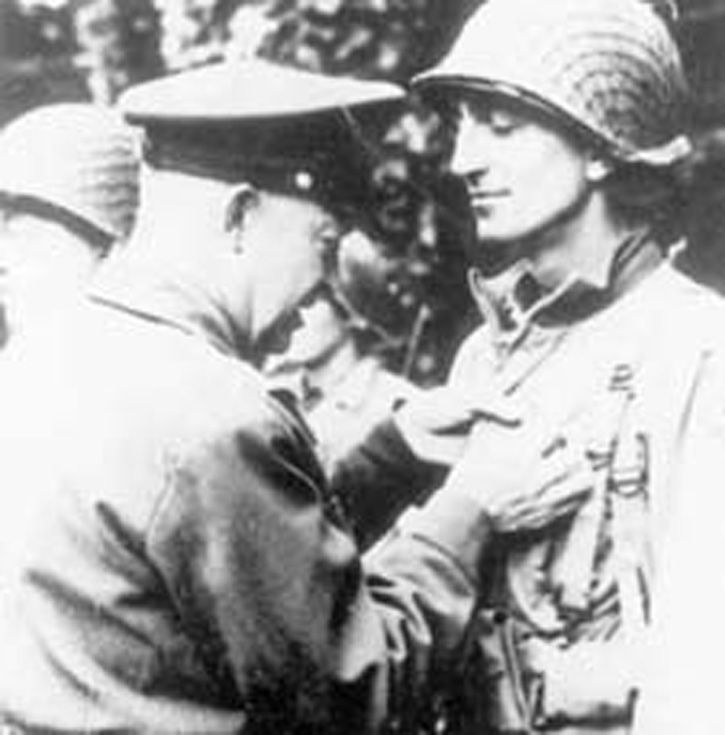
Courage: Capt. Joe Dawson receives the Distinguished Service Cross from Gen. Dwight Eisenhower, Supreme Allied Commander, July 2, 1944. Dawson rallied troops to move off Omaha Beach and forward up the bluffs, taking out German emplacements.
It is the photo and the caption apparently has the right date. I had always thought that this ceremony was done on the bluffs above Omaha where the cemetery now is during Eisenhower’s first visit because that was what the veterans remembered to me, perhaps after a few too many drinks. The facts suggest that they may have met Eisenhower twice, first in June and later on 2 July when the medals were awarded.
In today’s world the democrats would have supported Japan
Hitler and Tojo had no idea what they had taken on.
Amazing too on how those same guys would be ready to go at another island in a few months. My dad was on a Minesweeper and I have all of his old letters. He talks about a marine coming aboard to visit his brother. My dad compared his easy life with that of the Marine (”He killed 8 Japs that he knew of, two with his knife as they jumped into his foxhole.”)
He said the Marine was heading out the next day to an operation “that you will hear about by the time you get this letter.”
Looking at the dates it must have been Tinian, which was a VERY costly victory for us. I wondered if that Marine made it out of that one.
Both fronts were crying for more men.
Although bought at a terrible cost, you could argue Saipan and Tinian won the Pacific war. That’s where the bombing campaign was based and where Enola Gay picked up the bombs.
The Pacific campaign was run on a shoestring from a manpower perspective. The priority was Europe. Even there we cut it close. At the height of the Battle of the Bulge we had no more reserves in theater to throw into the battle.
Disclaimer: Opinions posted on Free Republic are those of the individual posters and do not necessarily represent the opinion of Free Republic or its management. All materials posted herein are protected by copyright law and the exemption for fair use of copyrighted works.